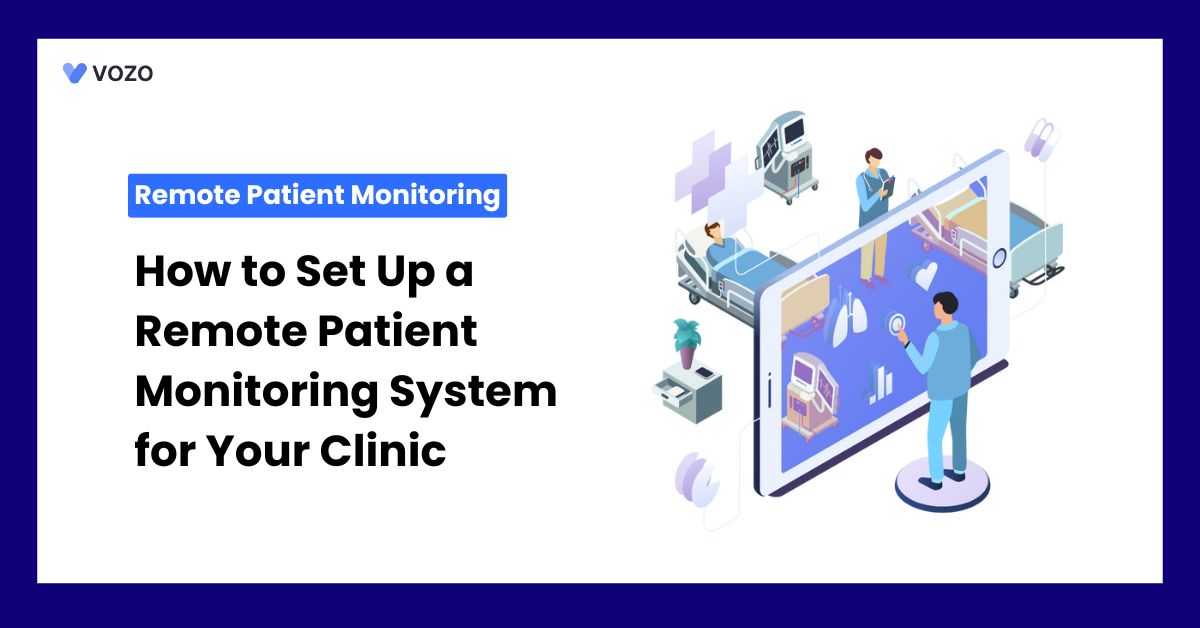How to Set Up a Remote Patient Monitoring System for Your Clinic
As healthcare continuously evolves and people expect convenience in care, Remote Patient Monitoring (RPM) has become an essential tool more than ever. RPM enables the tracking of a patient’s vitals in real-time, the detection of early warning signs, and the intervention before complications arise.
The RPM Market was valued at USD 39.54 billion in 2023 and is predicted to reach USD 77.90 billion by 2029, growing at a CAGR of 11.97%. This highlights the critical need for implementing RPM for clinics.
But how do you implement it effectively? In this blog post, we have shared the step-by-step process of setting up an RPM system.
The Growing Need for Remote Patient Monitoring
Many patients prefer convenient healthcare, so the urge to implement RPM solutions is important. RPM is also important for continuously monitoring patient vitals. For instance, a patient with high blood pressure visits your clinic once every three months, and their condition fluctuates between those visits.
However, as a provider, you only find out when something goes wrong. Lately, it might be too late to prevent complications. This is where Remote Patient Monitoring comes in.
RPM technology enables real-time health tracking, which clinicians can use to monitor patients’ vitals, intervene early, and improve patient outcomes. RPM has proven crucial, especially for controlling chronic diseases such as diabetes, hypertension, and heart disease.
Why is Remote Patient Monitoring Important Than Ever?
According to strategic marketing research, 65% of clinicians use remote patient monitoring technology for medical management, and 60% use it to improve care coordination.
This highlights the critical need for RPM more than ever. Moreover, here are some of the aspects that highlight the need for remote patient monitoring:
- Heart disease, diabetes, and respiratory disorders necessitate ongoing monitoring.
- Many people prefer virtual healthcare to frequent in-person visits, particularly the elderly and those living in rural places.
- RPM helps to reduce hospital readmissions while freeing up clinic resources for urgent situations.
- Many healthcare systems now recognize and compensate for RPM services which makes RPM a worthwhile investment.
RPM is more than simply technology, it is about providing better treatment, early intervention, and improving the doctor-patient connection without the need for frequent hospital visits.
Comprehensive Guide to Implementing Remote Patient Monitoring Program in Your Clinic
Here is the guide to implementing a Remote Patient Monitoring program in your clinic:
1. Assessing Patient Needs and Clinic Readiness
Before implementing RPM in the clinic, clinicians need to evaluate a few things which include:
- Which patients would benefit the most from the RPM program? (e.g., those with chronic conditions, post-surgery recovery, high-risk pregnancies).
- Does the clinic’s IT infrastructure support RPM? (EHR integration, secure data storage, trained staff)
- What are the costs vs. benefits? Will insurance reimburse for RPM services?
Make sure to evaluate these things. Then start with a pilot program. For instance, test RPM with a small group of patients before scaling up.
2. Selecting Appropriate RPM Technologies
The success of RPM implementation depends on choosing the right tools. Here are some of the factors to consider while selecting the appropriate RPM technologies:
- User-friendly devices like Blood pressure monitors, glucose meters, and pulse oximeters.
- Devices that connect with your EHR system for automatic data transfer.
- HIPAA-compliant platforms that protect patient privacy.
- Ensure vendors provide reliable customer support in case of device.
Make sure to choose the right RPM devices that align with your specialty practice. For instance, If your clinic primarily treats cardiac patients, prioritize ECG monitors and heart rate trackers over general health monitoring devices.
Related: Monitoring Patients Remotely? You’ll Need These Top 6 Devices
3. Developing a Structured Implementation Plan
Implementing RPM isn’t just about technology, it’s about the process and strategy for successful implementation.
- What metrics will you track? (e.g., blood pressure trends, medication adherence)
- Who monitors the data? How often do doctors review it?
- Will there be weekly check-ins via video calls or automated alerts?
Assign a dedicated RPM coordinator to oversee the program and ensure smooth operation.
Related: 7 Different Health Vital Signs and Medical Devices to Monitor
4. Training and Engaging Clinical Staff
More than just implementing RPM, it is important that staff is utilizing the technology properly. Because Even the best RPM system is useless if staff doesn’t know how to use it.
- Train doctors, nurses, and support staff on device usage, data interpretation, and patient engagement.
- Encourage an RPM-first mindset, and show how it can reduce workload and improve efficiency.
- Address concerns can help staff understand that RPM is an assistant, not a replacement for in-person care.
Clinics should consider running practice sessions where staff use the devices themselves before introducing them to patients.
5. Patient Onboarding and Education
Patients are more likely to stick with RPM if they understand its value. So, seamless onboarding of patients and providing education to them in using the RPM Program is important.
- So, Keep instructions for onboarding simple and jargon-free.
- Provide step-by-step guides or video tutorials on using the devices.
- Address common concerns like What if the patient doesn’t understand the readings?
Also, clinics should consider having a support helpline for patients struggling with the technology.
6. Data Management and Security Protocols
Since RPM involves sensitive patient data, security is non-negotiable. When implementing RPM, consider:
- Using encrypted platforms to prevent unauthorized access.
- Implement role-based access control (Only authorized staff should see patient data).
- Educate patients on data privacy and how their information is used.
7. Continuous Monitoring and Program Evaluation
Once the Remote Patient Monitoring Program is implemented and running, the clinic should track its performance. Clinics must:
- Regularly review patient outcomes and engagement levels.
- Get feedback from staff and patients to refine the system.
- Identify gaps and improvements for instance (Are patients using the devices correctly? Are alert thresholds set appropriately?).
Related: Can Remote Patient Monitoring Cut Readmissions by 50%?
Vozo’s Remote Patient Monitoring Solution
Remote patient monitoring brings healthcare checkups to your handy place. With the support of RPM devices, healthcare practices become straightforward and convenient for both patients and providers.
Vozo RPM solution is the best option to adapt for healthcare professionals. Our remote patient monitoring solution will help to track and evaluate patient vital signs and health data.
It is advantageous to communicate with patients digitally to adjust treatment plans and educate them about their health conditions. Our RPM program will allow you to improve patient health outcomes and reduce readmissions.
Leverage Vozo’s Remote Patient Monitoring Program to provide healthcare conveniently.
About the author

With more than 4 years of experience in the dynamic healthcare technology landscape, Sid specializes in crafting compelling content on topics including EHR/EMR, patient portals, healthcare automation, remote patient monitoring, and health information exchange. His expertise lies in translating cutting-edge innovations and intricate topics into engaging narratives that resonate with diverse audiences.













